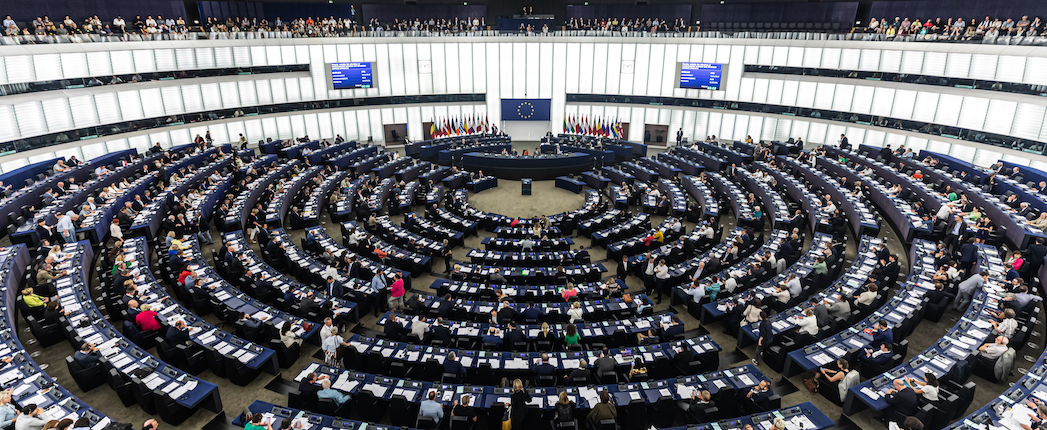
The European Parliament adopted large parts of the EU climate protection package “Fit for 55” with a large majority in Strasbourg on April 18.
“With this decision, Europe will lead the green revolution and become the first climate-neutral continent,” said President of the EU Parliament Roberta Metsola.
With the package, the EU wants to reduce its carbon dioxide emissions by 55% by 2030 compared with the level in 1990 and become climate neutral by 2050 in line with the European Climate Law.
The three areas on which the EU Parliament has now voted – the Emissions Trading System, the Social Climate Fund and the Carbon Border Adjustment Mechanism – are considered center pieces of the package that the European Commission presented in mid 2021 to fight climate change.
EU heads of state and government must still approve the legislation, but this is a formality.
A core element of Fit for 55 is the tightening of emissions trading, as it makes climate-damaging production more expensive and climate-friendly production cheaper through the possibility of having to buy fewer rights or sell surplus rights via the stock exchange.
As a result, the emission of 1 metric ton of CO₂ now costs almost €100 – five times more than three years ago. Industries covered by the system must reduce emissions by 62% by 2030 compared with 2005. Previously, they only had to reduce by 43%.
The ETS has been in place for almost 20 years. The idea is to put a price on CO₂-emissions. Those who emit less will profit and those who emit more must buy certificates.
Emissions trading is a central instrument for European climate protection. Companies, for example, must buy pollution certificates if they emit CO₂. This is meant to create an incentive to produce less CO₂.
EU legislators are now tightening up the system. In the fight against climate change, the European Parliament decided on an expansion of emissions trading on Tuesday. The number of pollution rights is to be reduced more quickly than previously planned. Free certificates for companies will be phased out by 2034.
The reform also includes other steps. Airlines, which already also must buy emission allowances for flights inside the EU, will gradually get fewer free allowances. From 2026, they will have to pay for pollution rights completely themselves This will promote the use of sustainable aviation fuels.
Depending on a study yet to be prepared, waste incineration plants will also be included in the trading system from 2028.
Similarly, free rights for industry will also be phased out by 2034. Overall, 75% of emissions from the EU region are to be covered by the trading mechanism in the future. Currently, the share is 40%.
With the reform, shipping will also be included in emissions trading for the first time. A separate trading system is to be created for buildings and road transport. These sectors have not been subject to emissions trading so far.
Producers abroad will also pay for CO₂ emissions in the future if they want to sell their goods in the EU. This will be done through a so-called CO₂ border adjustment. The CBAM will apply fully from 2034.
CBAM is intended to motivate non-EU countries to set higher climate protection targets. It is also intended to ensure that climate protection efforts are not undermined by shifting production from the EU to states with less stringent climate protection regulations.
The system applies to iron, steel, cement and aluminum, as well as fertilizers, electricity and hydrogen. Anyone who wants to import these goods must compensate for the difference between the CO₂ price paid in the country of production and the higher price of CO₂ certificates in the ETS.
The EU will phase in the CBAM from 2026 until 2034 at the same rate that it phases out free allowances in the ETS.
“The CBAM strengthens the “polluter pays principle’ as the basis for a sustainable industrial policy. Such a mechanism protects the European market from climate dumping from third countries with weaker environmental standards,” praised the environment and climate policy spokesperson of the European Social Democratic Party, Delara Burkhardt.
The EU Parliament voted to set up an EU Social Climate Fund by 2026 “to ensure that the climate transition will be fair and socially inclusive.” Higher costs for consumers due to the energy transition, such as rising heating costs, are to be absorbed by a fund worth €86.7 billion from 2026. This can be used to relieve households or to finance investments, for example, in more efficient buildings or public transport. Revenues from emissions trading will finance three-quarters of the fund and one-quarter by the member states.
MEP Peter Liese, who helped negotiate the Fit for 55 package, calls it the “biggest climate protection law ever.” President of the EU Commission Ursula von der Leyen called the parliamentary vote a “milestone” for climate protection.” The Green negotiator in the EU Parliament Michael Bloss said, “The era of free pollution is over.” To me this means that those who produce in a climate-friendly way in the future will save cash or, in other words, increase profits. Thus, “Fit for 55” means “Profit for Zero” emissions.
STAY SuSTAYnable!


Sorry, a technical error occurred and we were unable to log you into your account. We have emailed the problem to our team, and they are looking into the matter. You can reach us at cs@lubesngreases.com.
Click here link to homepage